Enotria: The Last Song on PC
When talking about the fundamentals of combat, enemy design, and exploration, Enotria: The Last Song is the closest thing I’ve played to a FromSoftware-certified Soulslike. It’s a faithful recreation of the original formula from Dark Souls 1 with enough flavor and flare in its presentation to keep you entertained and engaged. Enotria: The Last Song will be an excellent albeit bumpy experience for lovers of the Souls genre, but it lacks certain aspects that hold it back from being a truly polished gem.
I don’t think it’s controversial to say that the market has been saturated with Soulslikes over the past year and many people are starting to be fatigued by it. You can only do the same thing over and over so many times before it becomes a chore. Luckily, Enotria: The Last Song does bring enough innovation and personality to stand on its own and not feel like a cheap imitation. However, some of this personality does come at a cost.
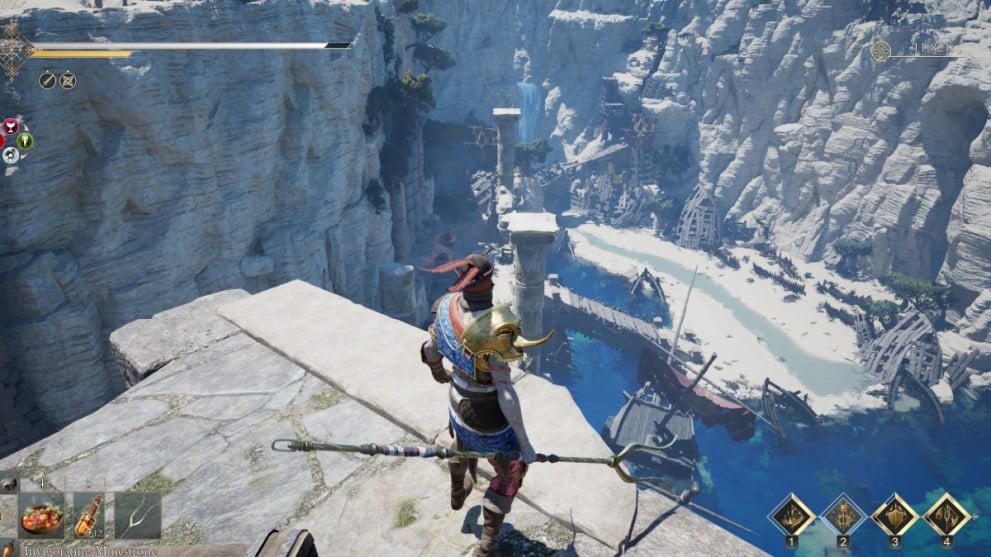
Enotria: The Last Song is the first major release from Jyamma Games, an Italian independent game studio that has made it their objective to tell tales from Italian folklore and paint an experience that is distinctly soaked in Italian culture. Their dedication to the culture is bold and uncompromising, which is highly respectable but can be jarring at times. The good has to do with a distinctly Italian paint job over the vehicle known as Dark Souls to give it a fresh new personality. Meanwhile, the bad has to do with a lot of disconnect between the game and those unfamiliar with the culture it draws inspiration from.
To start off, most of the names, item names, Element names, spell names, spell recharge speeds, and several story beats are all in Italian or have a connotation. Those familiar will probably love this, and even I found it charming whenever I could understand anything without having to Google it. However, when you can’t understand the difference between spell recharge speeds (they’re Italian) or everything starts becoming a jumble of words, you realize there’s a reason that even games like Black Myth: Wukong which draw heavily from their own culture, make a lot of effort for localization.
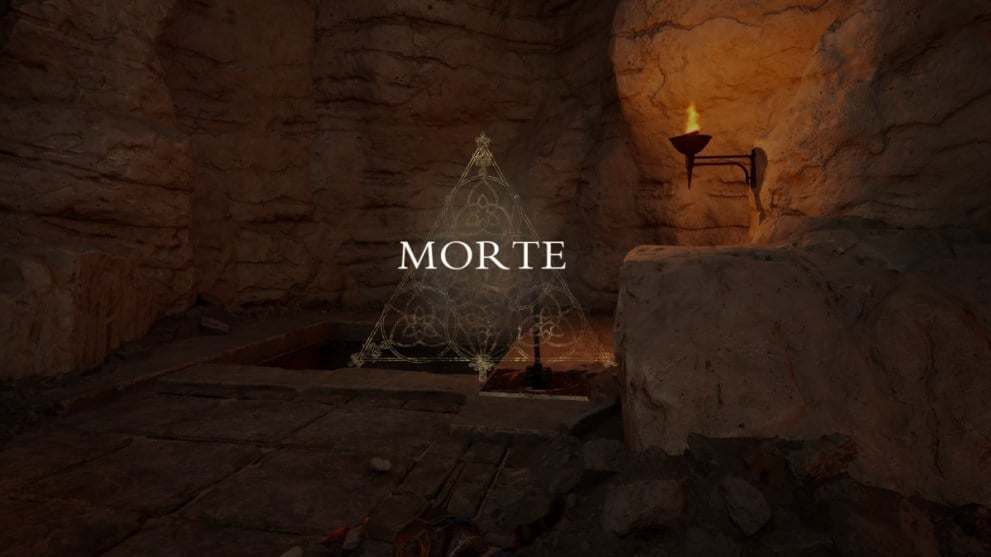
Jyamma Games is a smaller studio with a smaller budget, so this can be forgiven. So, with the basic premise out of the way, let’s get into the meat of Enotria: The Last Song and see what ‘Dark Souls Made in Italy’ brings to the table.
Enotria: The Last Song is a pure Soulslike that opens with you, a chosen nobody born in a stagnating world now tasked with taking down the powerful godlike beings causing this decay. Set forth puppet and march on with the standard gameplay loop of going from checkpoint to checkpoint as you take down enemies in your path and make your way through bosses. On this path, you’ll also get to do some quests in a guided but still confusing soulslike fashion. So let’s go over everything one by one.
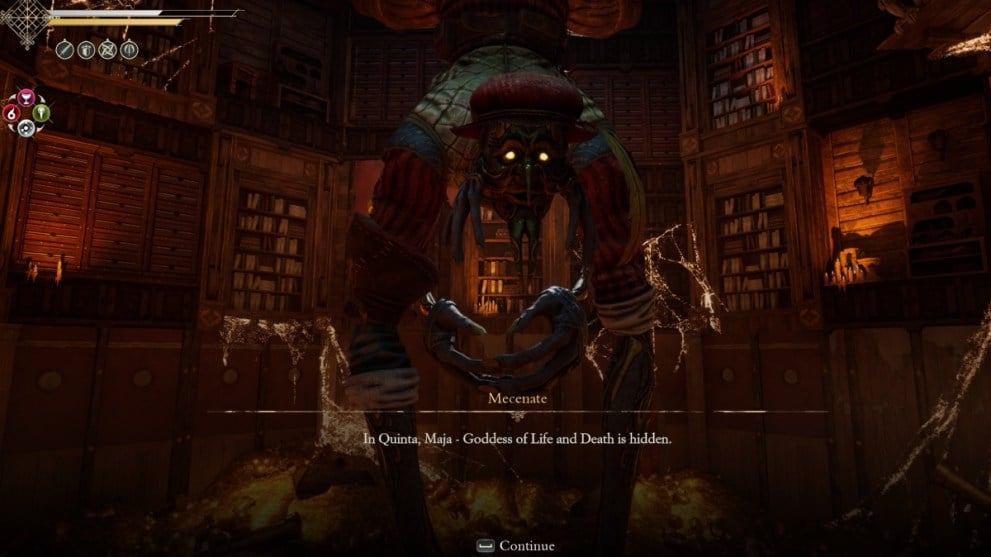
First off we have the basics of melee combat. This is where Enotria has both innovated and changed very little; let me explain. Combat is your completely standard light attack, heavy attack formula with a stamina meter and healing flasks. Your dodge is more like a small dash, similar to Bloodborne, and your left hand is only used for parries and blocking. The parry timing is much more forgiving than most games and the game expects you to do a balancing act between constantly attacking and then parrying strings of attacks, which feels amazing once you’re in the flow. The parry meter and your attacks work towards building up a meter that lets you land a critical hit to enter an empowered state.
Then you have the RPG mechanics of this game, and you’re either going to love them for all the flexibility you have or completely hate them due to how complicated they feel as they throw you straight into the whole system. The first few hours of the game are quite simply, overwhelming. There are many RPG systems to figure out and your enjoyment of the game will be decided by how much these click with you. Let’s get into them one by one.
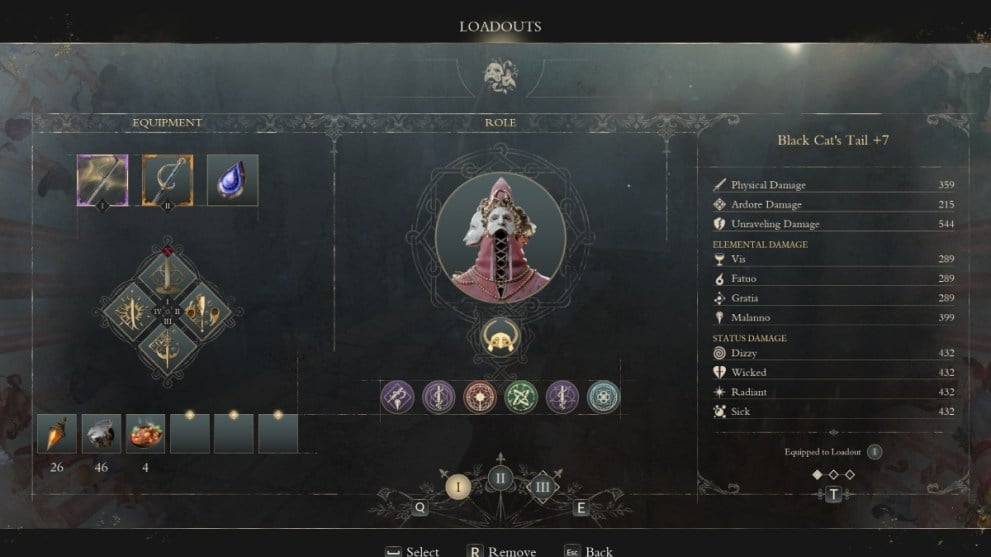
First of all, and this might be the most confusing part of the game when you start, you will have access to three Masks on the fly. You can set the loadout for each of these at the checkpoints and then swap between them at the press of a button mid-combat. Each class has two Weapon slots, four Mask Line slots, six Passive lots, one Mask Slot, and one Role Slot. If you’re an RPG enthusiast, the idea of building three different characters to swap on the fly with so many choices available is amazing. You can build a mage, a duelist, and a tank at the same time and swap between them on the go. If that sounds like way too much for you, well at least it’s completely optional.
Now that we have three characters available, let’s start with the weapons. In Enotria: The Last Song, there are around 120 weapons in total from around six different classes. However, most of these function the same. You have your medium-speed Polearms, Spears, and Longswords, and your slow-hitting Colossal Hammers and Greatswords. Each weapon has a light, heavy, and jumping attack. The fun comes from discovering these weapons and exploring their movesets. A lot of weapons by default have an infused ability on either their heavy or jump attack, and usually, this will always be the deciding factor for choosing a weapon or not. It’s simply too cool to pass up, which is a bit of a shame because 120 weapons is a lot to choose from and you should be encouraged to try out all of them.
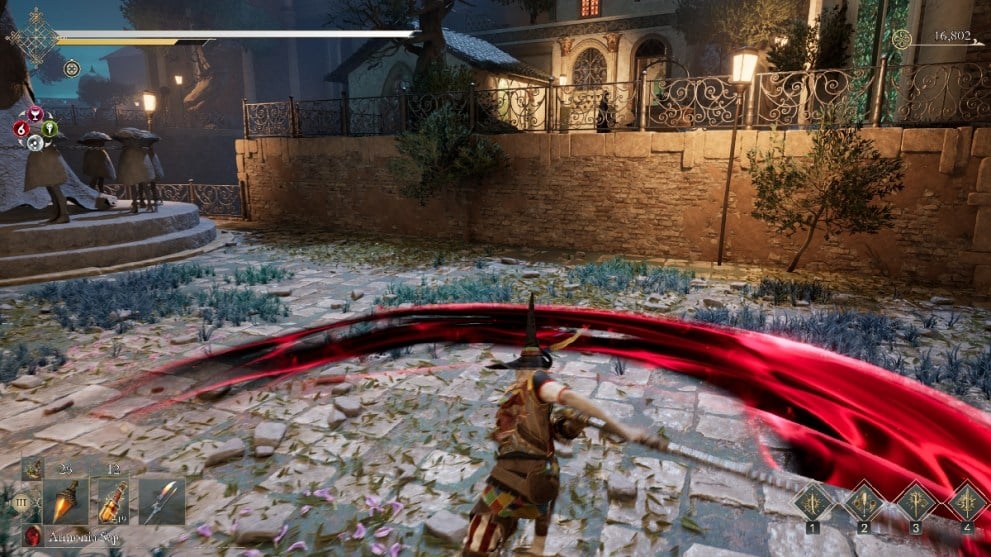
Speaking of infusions, Enotria: The Last Song has a very simple but initially confusing elemental system. There are four elements, I’m not going to go into their Italian names, but having finished the game I still call them Fire, Wine, Corrosion, and Holy. Fire beats Wine, Wine beats Corrosion, Corrosion beats Holy, and Holy beats Fire. It’s an interesting rock-paper-scissors system that encourages you to at least have one type of weapon for each Element.
It’s not just 120 weapons, you also have four spell/arts slots known as Mask Lines. These are the magics and abilities you charge up by attacking enemies. Figuring out a chain of light/heavy attacks and comboing into your Mask Lines is one of the most satisfying things possible where I would say Enotria surpasses even Dark Souls when it comes to engaging combo-focused combat. There are over 50 of these and you can slot in four of them. These range from powerful AoE attacks to simple variants of elemental attacks,
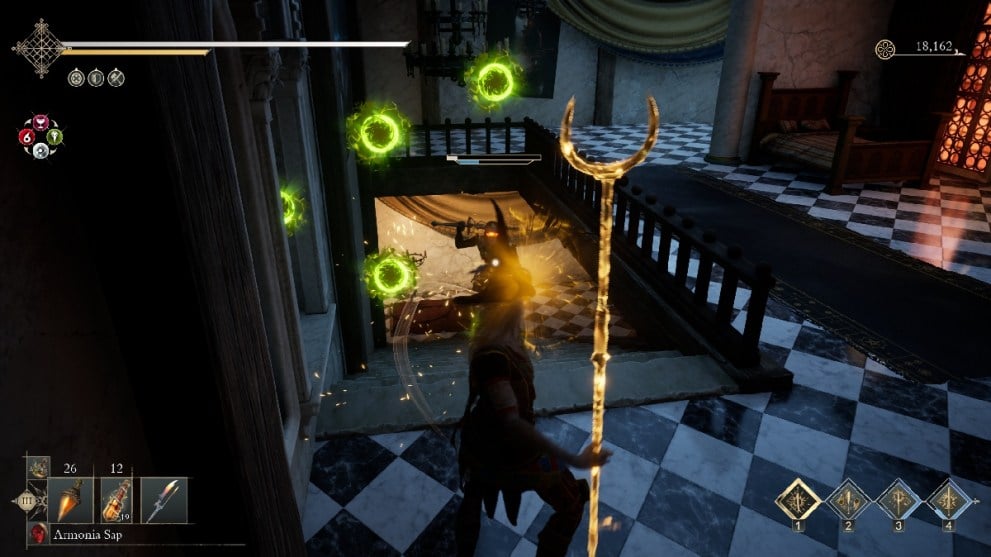
Do note that weapon attacks and Mask Lines will lock you into the animation and you cannot cancel it with a dodge or jump, just like the original Dark Souls. Every input is a deliberate commitment to an action and if it gets interrupted you will absolutely get punished for it. Hardcore Souls fans might love this feature and enjoy the much more deliberate style of gameplay, but I can say from experience that it can also feel almost clunky or unfair at times.
There’s also the Mask and Role system. The Mask simply lets you take on the appearance of defeated enemies and bosses to gain a passive from them. The Roles are more impactful as they can directly increase and decrease your five main stats to spec them towards a certain style of gameplay. These are what allow you to play any kind of role despite the stats you put your levels into. Once you’ve made a decent amount of progress in the game, you’ll be able to create three completely distinct roles and then some to swap between on the fly.
Lastly, we have the passives system that lets you unlock passives that benefit a Trickster (Stamina and other effects), a Bruiser (Tanky Melee), a Battlemage (Mask Line charge and damage), and an Elementalist (Status effects). You can equip six at a time in each class and these range from giving minor benefits to being complete game changers as you go on and unlock them.
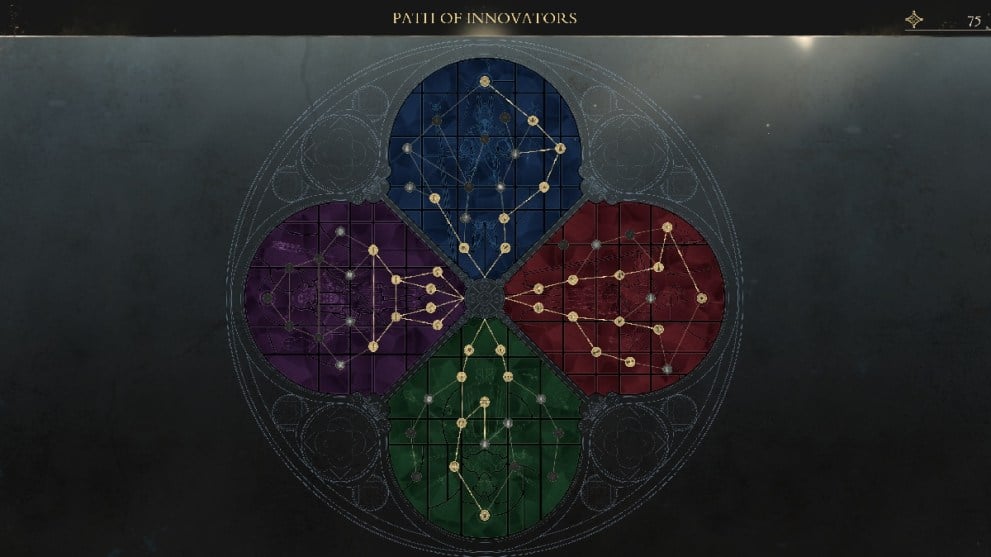
As for the leveling, weapon upgrades, merchants, travel, respeccing, healing, and soul drop systems, they all follow the standard Dark Souls formula. Almost no changes there. They have however embraced the revolutionary jump button from Elden Ring and some other quality-of-life changes.
One of the most important factors when it comes to judging the quality of a Soulslike, is the quality of the boss fights and enemies. Enotria The Last Song is in a weird spot where these range from thrilling to middle of the road to straight-up boring. It’s never boring enough to make you stop playing, but you can only fight ‘dude in armor’ or reskins of the previous boss designs enough times before it loses that sense of spectacle and charm. It doesn’t help that exploring thoroughly can get you overpowered enough to make many boss fights a complete joke. However, at its best, Enotria provides some incredibly engaging encounters that I would’ve loved to see more of.
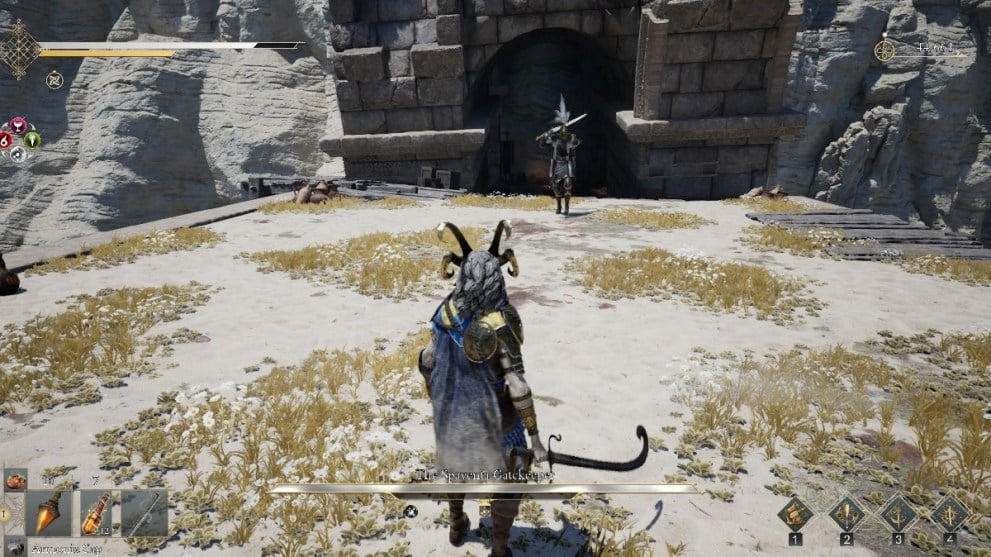
Remember that dance of attacks and parries I mentioned earlier? Well, some bosses fully hone in on this and keep you on the edge of your seat always reacting, planning your next attack, responding with a parry, and repeating this whole cycle until one of you falls in battle. All the while epic Italian folk music plays and you get completely pulled into the flow of the game. There is a larger margin for error making these fights more forgiving, and while that does make you feel safe, it does not take away from the thrill of the many great boss fights in Enotria.
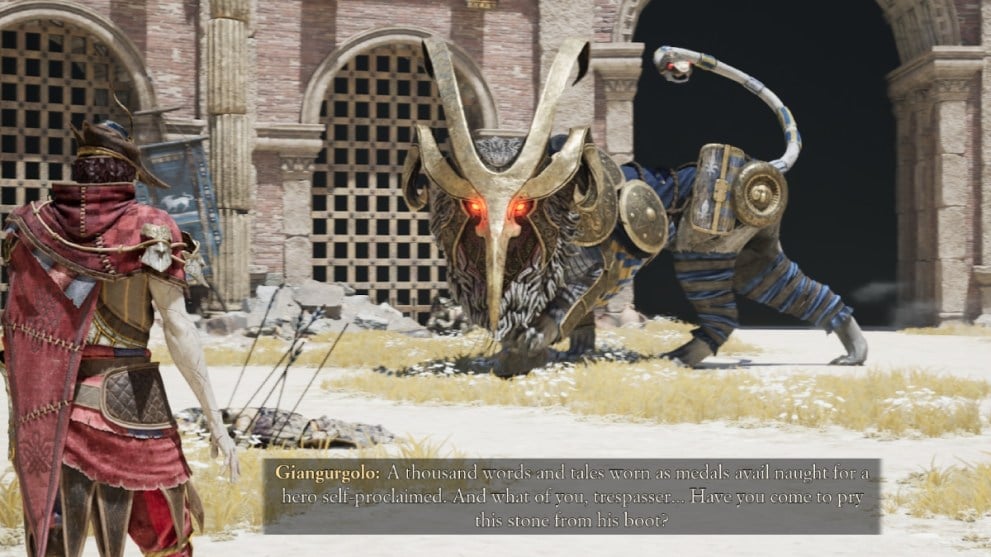
I wish I could say the same for the regular enemies, as they don’t have too much in the way of personality or variety. Some enemies you will curse even after you’ve beaten the game. However, with most enemies, it’s figuring out how and what you can use to stunlock them till they die. For most of them, it’s going to be a heavy attack, and it will unfortunately remain the optimal way to deal with any and all enemies until you finish the game.
Get enough stamina, chain light attacks into heavy attacks for quick stunlocks, rinse and repeat and you should be able to deal with about 70% of the enemies. The remaining 30% are still tough challenges, but with only two or three unique elites like that in each area, you can figure out their formula fairly quickly. Additionally, a lot of the difficulty will come from fighting against the weird camera lock-ons while being stuck in animations. Prepare to fall off while attacking enemies near ledges, like a lot.
One thing Enotria: The Last Song does very well is the level design. If you can see it and think you can go there, you most probably can. The levels and environments look drop-dead gorgeous and at many points of the game, even if I got bored by the combat itself, the stunning environments and creative level design kept me engaged and wanting to see more.
While you will definitely feel a bunch of Unreal Engine jank and at times feel like assets were just thrown there, the game paints a beautiful picture of a mountain city drowned in revelry, an impenetrable city on a cliffside next to the beach, and a city blinded by science and greed with haunting alleys that will give you flashbacks to Bloodborne. Exploration is always worthwhile. From start to finish you will be treated with eye-candy with each new area and location discovered.
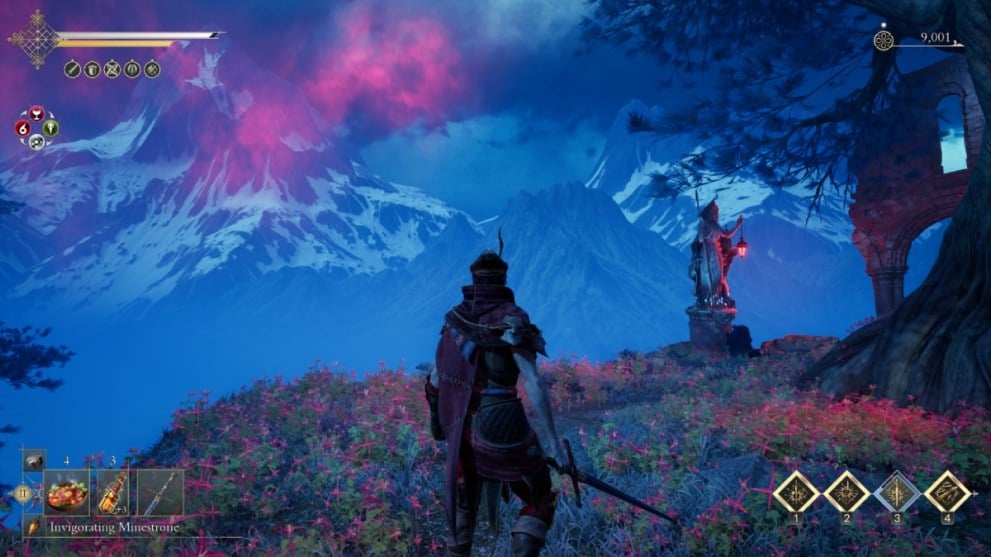
Each new area explored could lead to a powerful new weapon, a new Mask Line, a new secret boss, or some other cool challenge. These locales and looping-level designs that reward you for every bit of exploration keep the experience palatable even in its lowest moments. Unfortunately, there are quite a few of these low moments that take away from what would otherwise be a breathtaking experience.
The beauty of these landscapes and new areas is often marred by terrible performance and FPS drops. The game is almost unplayable on PC above 30 FPS if you’re not enabling DLSS while playing on Ultra (which for some reason I could not lower), even with an RTX 3070 and Ryzen 5700 setup. It’s not that these issues are present all the time, but they pop up frequently enough to tarnish the overall gameplay experience.
Speaking of tarnished gameplay experiences, besides the performance issues there are several bugs (at least in the pre-release version) that may repeatedly crash your game, cause weird teleports, and break enemy AI. For example, a waterwheel I was supposed to climb spawned inside a building at a weird tilt halting my progress until I restarted. This bug was just funny, but the time an elevator glitch dropped me off the top for pressing a lever costing me around 100,00 currency was just infuriating.
I could go on about minor bugs but I’ll focus on a big one that will help summarize them all. During the final climactic boss fight, first of all, the music stopped playing for some reason. Afterwards, not once, not twice, but the final boss’s AI stopped working three times and he just stood there taking hits. As a reviewer, this was a blessing, but as a player that completely ruined what would otherwise have been an amazing final boss experience.
Bugs like these and the aforementioned issues related to performance and enemy difficulty keep the game from being what could otherwise be a truly flawless experience. Fix the enemy variety, fix the performance issues and bugs and this game would make a spectacular entry as Jyamma Games’ first large project. The difficulty issues I mentioned can be considered subjective, but developers skipping out on performance optimizations and hoping for DLSS to fix them isn’t something I can paint in an optimistic light. Hopefully, Jyamma Games is able to iron out these issues by the time the official release drops.
Until then, if you’re someone who loves the formula of the original Dark Souls, including parts of the jankiness that made it charming, you’ll feel right at home with Enotria: The Last Song, despite the performance issues.
- Stunning visuals, area designs, and very satisfying exploration
- In-depth RPG mechanics with a lot of choice
- The game never stops being engaging
- Frequent performance issues and FPS drops
- Several game breaking bugs and crashes
- Lack of enemy variety
- RPG mechanics might be a bit too much for new players

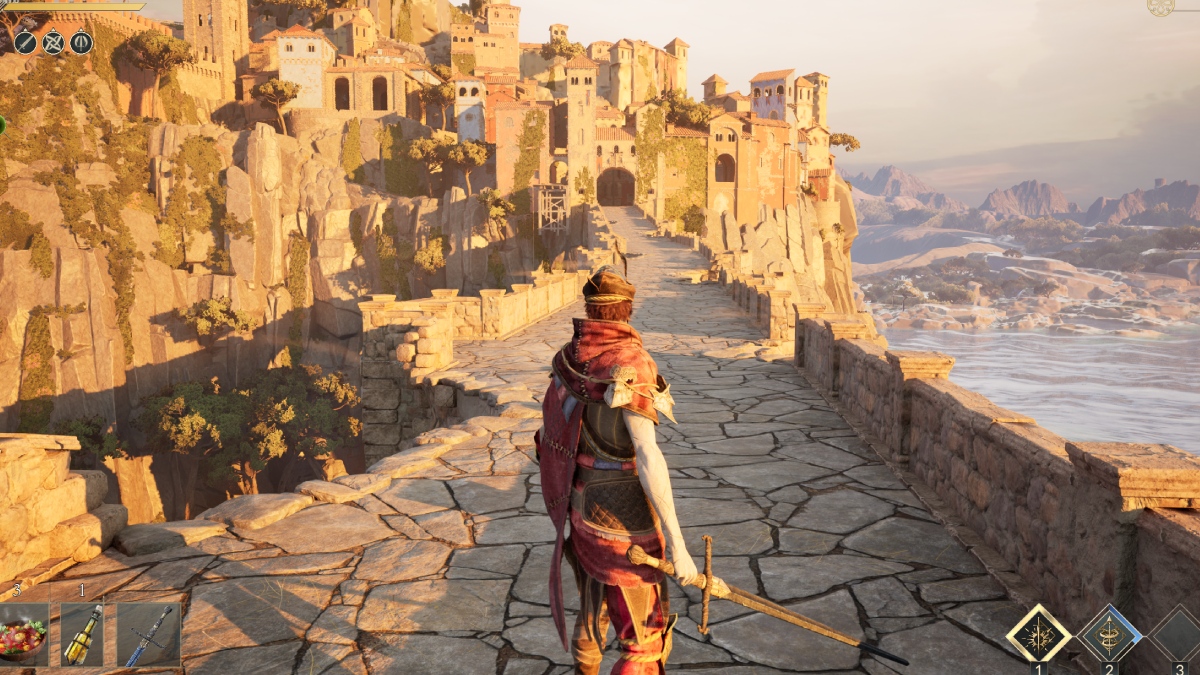











Updated: Sep 17, 2024 06:03 am